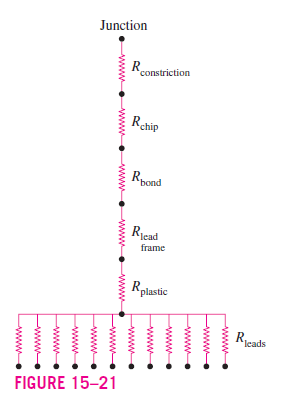Analysis of Heat Conduction in a Chip
A chip is dissipating 0.6 W of power in a DIP with 12 pin leads. The materials and the dimensions of various sections of this electronic device are as given in the table below. If the temperature of the leads is 40^{\circ}C, estimate the temperature at the junction of the chip.
| Section and Material | Thermal Conductivity, W/m · °C | Thickness, mm | Heat Transfer |
| Junction constriction | — | — | diameter 0.4 mm |
| Silicon chip | 120^{†} | 0.4 | 3 mm × 3 mm |
| Eutectic bond | 296 | 0.03 | 3 mm × 3 mm |
| Copper lead frame | 386 | 0.25 | 3 mm × 3 mm |
| Plastic separator | 1 | 0.2 | 12 × 1 mm × 0.25 mm |
| Copper leads | 386 | 5 | 12 × 1 mm × 0.25 mm |
^{†} The thermal conductivity of silicon varies greatly with temperature from 153.5 W/m \cdot ^{\circ}C at 27^{\circ}C to 113.7 W/m \cdot ^{\circ}C at 100^{\circ}C , and the value 120 W/m \cdot ^{\circ}C reflects the anticipation that the temperature of the silicon chip will be close to 100^{\circ}C .

